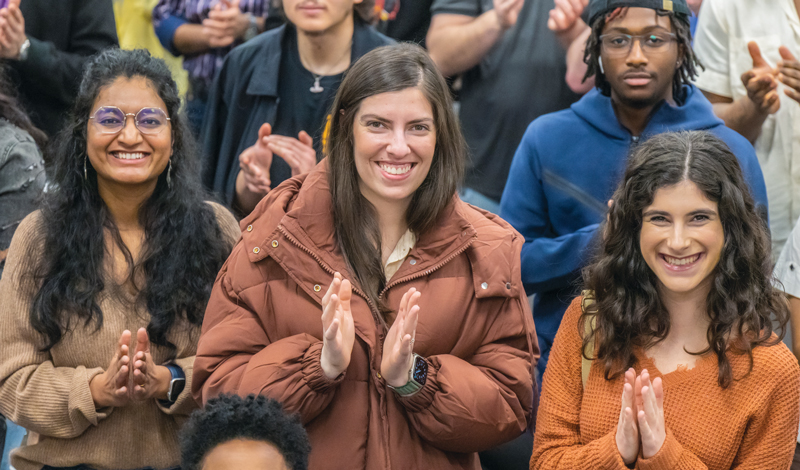Academy members should:
• be district through national youth leaders.
• have their own copy of The Wisdom of the Lotus Sutra, vol. 1.
• read the assigned material prior to each meeting.
JULY SYLLABUS
The Wisdom of the Lotus Sutra, vol. 1, pp. 139–64
Part Three: “Expedient Means” Chapter
• The Revelation of the Single Buddha Vehicle: Opening the Door to the Oneness of Mentor and Disciple
Supplementary Materials:
• The Lotus Sutra and Its Opening and Closing Sutras, pp. 56–81
KEY CONCEPTS
The Three Vehicles Replaced by the One Vehicle
Mahayana Buddhist teachings have been called “vehicles” because they carry, or guide, people to certain levels of awakening depending on the people’s capacities. There are three vehicles for three respective groups of practitioners: voice-hearers, cause-awakened ones and bodhisattvas. The teachings for voice-hearers and cause-awakened ones are also known as the two vehicles.
The three vehicles correspond to the seventh, eighth and ninth of the Ten Worlds (learning, realization and bodhisattva). Prior to the Lotus Sutra, the Ten Worlds were viewed as distinct realms in which inhabitants remained over many lifetimes.
Teachings directed at voice-hearers and cause-awakened ones, who were known for their insight into the workings of life, only addressed their desire for personal awakening, so could not lead them to Buddhahood. Teachings directed at bodhisattvas extolled the altruistic spirit of leading others to enlightenment, yet denied the possibility of enlightenment for those in the two vehicles. Thus, bodhisattvas, too, could not fulfill their vow to save all living beings or attain Buddhahood.
The Lotus Sutra’s revelation of the “mutual possession of the Ten Worlds” overturned this self-contradictory view. It teaches that the Ten Worlds aren’t fixed realms that we stay in but potential states of being, any of which we can freely manifest at any moment—including Buddhahood. Each of the nine worlds contains the world of Buddhahood, and Buddhahood contains the other nine worlds. The one vehicle teaches that all people, without exception, can become Buddhas.
The Lotus Sutra therefore replaces the teaching of the three vehicles by expounding the one vehicle, the single teaching that can lead all people to enlightenment.
—Prepared by the SGI-USA Study Department
WISDOM INTO ACTION

Bhavyaa
Atlanta
Living Buddhism: How does studying Buddhism connect to your daily life?
Bhavyaa: Last year, I chanted for a promotion at work. Unexpectedly, though, I was laid off. I had 60 days to get a job or I would have to leave the country. Around that time, we were studying for the Fifth Ikeda Wisdom Academy Exam. I determined to stay in the U.S. and take the exam.
As I studied, I realized that the whole purpose of Buddhist practice is to elevate my life state so I can be happy. In hindsight, losing my job was the best thing to happen, because I saw that I defined myself by my work, that I was basing my happiness on external factors. Although I was striving at work, I was so miserable. I realized that I am so much more than my work. I put that spirit into my applications, and that shift in my heart helped me get my current job.
Studying in the academy, I learned that struggles don’t need to make me miserable; struggles can be joyful. Buddhist study has enabled me to identify the times I forget to apply the “strategy of the Lotus Sutra,” or to put prayer first. It has given me the wisdom to say: “Yeah, I might be suffering in this moment. But I have Nam-myoho-renge-kyo, and I truly can change what I want to in my life.”
FOOD FOR THOUGHT
The Ten Worlds and Two Vehicles
Ikeda Sensei: In the pre-Lotus Sutra teachings, we find assertions that bodhisattvas can attain enlightenment but people of the two vehicles cannot; bodhisattvas rejoice at this and those of the two vehicles lament, while those in the human and heavenly realms give up all hope (see “The Meaning of the Sacred Teachings of the Buddha’s Lifetime,” WND-2).
But the bodhisattvas are deluding themselves here; they actually have no reason to rejoice in the idea that they alone will attain Buddhahood. …
Why did people fall victim to this misguided, contradictory view? Ultimately, it’s because no sutra other than the Lotus Sutra expounds the mutual possession of the Ten Worlds. This doctrine is found only in the Lotus Sutra. (The Wisdom of the Lotus Sutra, vol. 1, pp. 146–47)
• • •
Before the doctrine of the mutual possession of the Ten Worlds was expounded, the problems and concerns of others were regarded as something divorced and separate from oneself. But with the teaching of the mutual possession of the Ten Worlds, people came to realize that the attainment of Buddhahood by others was their own attainment of Buddhahood, while if others could not attain Buddhahood, then neither could they themselves. This dramatically transformed people’s view of life and the world. (WLS-1, 149)
• • •
As Nichiren Daishonin says, “The provisional sutras teach inequality, but the Lotus Sutra teaches equality” (Gosho zenshu, p. 816). The Lotus Sutra doesn’t preach equality as just a slogan; it teaches a way to happiness for oneself and others alike, addressing the conditions of our lives on a fundamental level and how those life conditions are expressed through the way we live our lives.
(WLS-1, 150)
Looking Forward: August Syllabus
The Wisdom of the Lotus Sutra, vol. 1, pp. 165–92
Part Three: “Expedient Means” Chapter
• The Heart of the True Aspect of All Phenomena: The Endless Challenge to Transform Reality
You are reading {{ meterCount }} of {{ meterMax }} free premium articles

